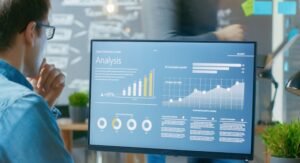Sales and Operations Planning (S&OP) is a vital process in Supply Chain Management that aligns the organisation’s strategies and operations to achieve its business objectives.
It is a continuous process that enables a company to balance its demand and supply, optimise inventory levels, and increase customer satisfaction.
S&OP is a collaborative effort that involves different departments, including Sales, Operations, Finance, and Supply Chain.
Its primary objective is to establish a balance between the company’s demand and supply by developing a forecast of demand and supply, which then leads to an integrated plan.
What is Sales and Operations Planning (S&OP)?

Sales and Operations Planning (S&OP) is a process in Supply Chain Management that involves cross-functional collaboration to develop an integrated plan that aligns the organisation’s strategies and operations to meet its business objectives.
The process involves a continuous review of the demand and supply of goods and services to ensure that they are balanced.
The Sales & Operation Planning process typically involves representatives from different departments, including Sales, Operations, Finance, and Supply Chain.
The objective is to align the demand forecast with the supply plan to ensure that the company can meet its customer’s requirements while optimising its inventory levels and maximising its efficiency.
The Process of Sales and Operations Planning
The sales and operations planning process generally involves the following steps:
- Demand Planning: This step involves creating a forecast of the expected demand for the company’s products or services. The forecast is based on historical sales data, market trends, and customer feedback.
- Supply Planning: This step involves determining the resources required to meet the expected demand. This includes creating a production plan, scheduling resources, and determining inventory levels.
- Pre-S&OP Review: This step involves reviewing the demand and supply plans to ensure that they are aligned and identifying any gaps or issues that need to be addressed.
- S&OP Review: This step involves a formal review of the demand and supply plans by senior management to ensure that they are aligned with the company’s strategic objectives and to make any necessary adjustments.
- Executive S&OP Review: This step involves a review of the S&OP plan by the executive team to ensure that it is aligned with the company’s overall strategy and to make any final adjustments.
Benefits of Sales and Operation Planning
The Sales department plays a crucial role in the sales and operations planning process by providing insights into market trends, customer behaviour, and demand patterns. This information is then used to fine-tune the demand forecast, ensuring that it aligns with the current market conditions.
The Finance department is also involved in the process, providing insights into the financial implications of the S&OP plan.
The sales and operations planning process helps companies to achieve several benefits, including:
- Improved customer satisfaction: By aligning demand and supply, companies can ensure that they meet their customer’s requirements, resulting in improved customer satisfaction.
- Reduced inventory levels: The S&OP process helps to optimise inventory levels, reducing the amount of working capital required to maintain the inventory.
- Increased efficiency: By aligning their operations with their strategies, companies can improve their efficiency, reducing lead times, and increasing productivity.
- Improved financial performance: By optimising inventory levels, reducing lead times, and increasing efficiency, companies can improve their financial performance.
The challenges of sales and operations planning
Sales and Operations Planning (S&OP) is a crucial process in Supply Chain Management, but it can also be challenging. Some of the challenges that companies face in implementing an effective S&OP process include:
- Data Availability and Accuracy: One of the most significant challenges of S&OP is having access to accurate and timely data. Companies may struggle to gather data from different departments or systems, leading to inaccurate forecasts and plans.
- Cross-Functional Collaboration: S&OP requires cross-functional collaboration and communication. However, different departments may have competing priorities or perspectives, making it challenging to reach a consensus and create an integrated plan.
- Resistance to Change: Implementing an S&OP process may require significant changes to the organisation’s structure, processes, and culture. Resistance to change can slow down the implementation process and hinder its effectiveness.
- Lack of Executive Support: Without strong executive support, it can be challenging to prioritise and implement the necessary changes to establish an effective S&OP process.
- Uncertainty and Volatility: The external environment can be unpredictable, with changes in demand patterns, supply disruptions, and economic fluctuations. These uncertainties can impact the S&OP process and require companies to continuously monitor and adjust their plans.
- Lack of Technology: S&OP requires advanced technology and tools to support data integration, analysis, and collaboration. Without these tools, companies may struggle to implement an effective S&OP process.
What’s next for sales and operations planning?
With the advent of new technologies, changing customer needs, and increasing market volatility, sales and operations planning is evolving to meet the changing demands of the business environment. Here are some of the trends and developments that are shaping the future of S&OP:
- Digital Transformation: The adoption of digital technologies, such as Artificial Intelligence (AI), Machine Learning (ML), and advanced analytics, is transforming the way companies approach S&OP. These technologies can help companies improve their forecasting accuracy, optimise their inventory levels, and enhance their decision-making capabilities.
- Demand-Driven Planning: Demand-driven planning is a customer-centric approach to S&OP that focuses on meeting customer demand while minimising inventory levels and lead times. This approach involves using real-time data and advanced analytics to forecast customer demand and adjust production and inventory levels accordingly.
- Sustainability and Resilience: With growing concerns about climate change and supply chain disruptions, companies are incorporating sustainability and resilience into their S&OP processes. This involves developing plans that take into account environmental, social, and governance (ESG) factors and building more resilient supply chains that can withstand shocks and disruptions.
Conclusion
The future of sales and operations planning is characterised by digital transformation, integrated business planning, collaborative planning, demand-driven planning, and sustainability and resilience. Companies must address the challenges they face by investing in technology, encouraging cross-functional collaboration, and ensuring strong executive support to establish an effective S&OP process.
Companies that embrace these trends and developments will be better equipped to meet the challenges of the future and achieve their business objectives.
If you are interested in pursuing a career in sales and operations planning, consider enrolling in Imarticus Learning’s supply chain management certification program offered by IIT. To learn more about Imarticus Learning’s supply chain management certification course, visit their website.












